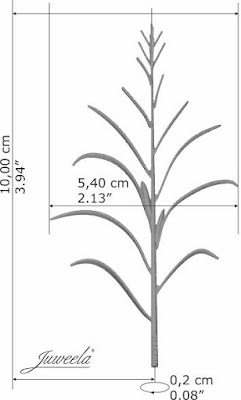Fields at Waterloo: Terrain Considerations & Modelling
From my research three crop types dominated the agricultural landscape of Waterloo in 1815 - Corn, Rye and Barley. Others were present but these three significant cereals were present in large fields and were nearing maturity and ready for harvest the month after the battle.
 |
| Winter Barley |
Barley (winter barley) fields appears predominately green but turns straw or golden coloured when time to harvest. Harvesting this winter crop occurs predominately in July/August throughout Western Europe. By June it is a beautiful 'golding' green and stands at about 4' high (average shoulder height).
 |
| Rye |
Rye (also a winter crop) stands at between 3' and 6' high and is a golden and green hue looking crop - less green than barley but far more washed out edging toward mature wheat fields in colour but still with an obvious greenish tint and definitely green in June.
Corn (or maize if you prefer) is sown in Spring (March/April) and is harvested from the end of August) growing to above head height. The type grown in Belgium at this time appears to have been fodder variants and not to be confused with the well known sweet corn crops.
All three crops grow like blazes through spring into summer. By 18 June in Belgium they would have been near to or at their full height and presented a significant and vast obscuring terrain feature until trampled down by the first waves of massed soldiery.
I intend to model my Papelotte table-top with these fields in full splendor which naturally presents some significant modelling challenges.
I want my fields densely cultivated but constructed as to allow the movement of my unit bases. The ground level terrain must allow for the limits of the crops to be defined whilst the interiors need to be massed, modular sections that allow for the dense crop sections to be moved around as the toy soldiers pass through.
I've never been satisfied with moving stands of figures on the top of crop features - it looks as bad as balancing oversized bases on narrow bridges or on buildings which can't properly accommodate them.
The rye and barley fields, whilst time consuming to model will nevertheless be capable of reasonable representation from a range of bristle stock. I've already been experimenting with Indian grass broom stock which works very well. I need to get the right shapes for the interior sections and I need to get the colours right.
The corn, on the other hand presents a real problem as they are so distinctive and have a complex structure and are a bugger to model satisfactorily in 28mm. Then I stumbled on the following product.
 |
| 1/32 scale plastic corn |
It is by Jaweela Models and sold by Secret Weapons Miniatures. They come in 50 piece packs at near USD20.00. I got a bit excited and with the time honoured declaration that 'sometimes you just need to throw money at a situation', I ordered 10 packs. Yes, I know - but I'll not want for corn crops ... amaizing (ahhh, couldn't help myself). They even provide the following dimension guide.
I have yet to receive them but they look very, very nice and if they are half as good in the flesh (so to speak) I'll be cock-a-hoop. I could never hope to make them. I've never seen a product before that does a better job. I can only imagine ACW gamers would go nuts over them. At 100mm tall they may need trimming for 28mm purposes.
I'm also considering what the trampled ground might look like. Artists often paint images of the fighting, dead or wounded fighting in a sea of grasses such as the following. This is definitely where longer synthetic fur sections cold really come into play.
Whilst this posting isn't really about anything I have done, it consolidates my thinking on the matter and helps be build my blue-print for the battle I plan to recreate. I often use my own blog as a diary and a notebook.





Comments
Post a Comment